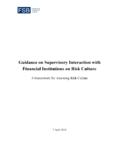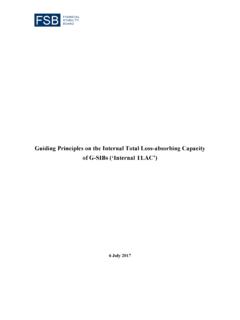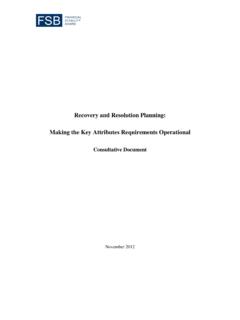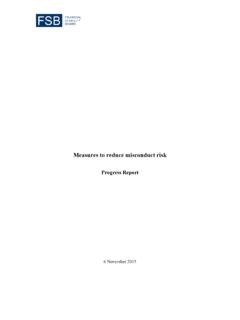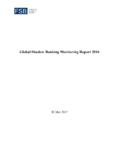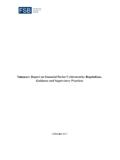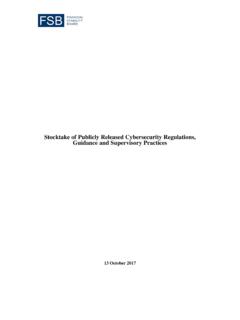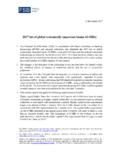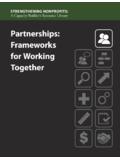Transcription of Chairs’ Report on the Implementation of the Joint Workplan ...
1 Chairs Report on the Implementation of the Joint Workplan for strengthening the resilience , recovery and resolvability of Central Counterparties 5 July 2017 Table of Contents Overview .. 1 I. resilience and recovery .. 2 Priorities for 2017/18 .. 3 II. Interaction between recovery and resolution .. 3 III. Resolution and resolution planning .. 4 CMGs for CCPs that are systemically important in more than one jurisdiction .. 4 Priorities for 2017/18 .. 5 IV. Interdependencies in central clearing .. 5 Priorities for 2017/18 .. 6 V. Impact of other regulatory initiatives on incentives to centrally clear .. 6 Priorities for 2017/18 .. 6 VI. Actions and timelines for 2017/18 .. 7 1 Chairs Report on the Implementation of the Joint Workplan for strengthening the resilience , recovery and resolvability of Central Counterparties Overview In 2009, the G20 Leaders committed to ensuring that all standardised over-the-counter (OTC) derivatives contracts are cleared through central counterparties (CCPs).
2 Since that time, the share of centrally cleared transactions has increased significantly and the range of banks and other financial institutions that channel their transactions through CCPs has broadened. CCPs criticality to the overall safety and soundness of the financial system means that authorities must take steps to ensure that CCPs do not themselves become a source of systemic risk. In 2015, the Chairs of the FSB Standing Committee on Supervisory and Regulatory Cooperation, the FSB Resolution Steering Group, the Committee on Payments and Markets Infrastructures (CPMI), the International Organization of Securities Commissions (IOSCO), and the Basel Committee on Banking Supervision (BCBS) agreed to coordinate their respective international policy work aimed at enhancing the resilience , recovery planning and resolvability of CCPs. They adopted a Joint workplan1 which called for the development of further guidance in those areas building on and supporting the Implementation of existing standards2 relating to CCP resilience , recovery planning, resolution and resolution planning, and analysis of central clearing interdependencies.
3 Implementation of the Workplan is now largely complete. The focus of the next phase of the work i s on: continued monitoring of Implementation of the principles in the PFMI regarding resilience and recovery of CCPs, and finalisation of the framework on supervisory stress testing for CCPs; the Implementation of the Key Attributes consistent with the expectations regarding CCP resolution and resolution planning expanded upon in the FSB guidance, supported by (i) the establishment of crisis management groups (CMGs) for CCPs that are systemically important in more than one jurisdiction (including the home jurisdiction) ( SI>1 ) and adoption of cooperation agreements, and (ii) further work on financial resources to support resolution and on the treatment of CCP equity in resolution; additional analysis of central clearing interdependencies to assess whether the key findings are stable over time.
4 And further work to assess incentives to clear centrally arising from the interaction of post-crisis reforms. 1 See 2015 CCP Work Plan at 2 CPMI and IOSCO Principles for Financial Market Infrastructures (PFMI) (2012) at and ; and the FSB Key Attributes of Effective Resolution Regimes for Financial Institutions (KA) (2011) and Annex to the KAs on Resolution of Financial Market Infrastructures (FMIs) and FMI participants (2014) at 2 I. resilience and recovery The CPMI and IOSCO PFMI provide a comprehensive framework for the resilience and recovery of CCPs. The CPMI-IOSCO Report of the first Level 3 assessment of selected CCPs Implementation of the PFMI3,4 found that CCPs have made important and meaningful progress in implementing arrangements consistent with the standards. However, the Report also identified some gaps and shortcomings with respect to their financial risk management and recovery practices.
5 To address these, the CPMI and IOSCO developed further guidance on CCP resilience and recovery . In particular, the CPMI and IOSCO have published the following reports: resilience of CCPs further guidance on the Implementation of the PFMI. The CPMI and IOSCO published on 5 July 2017 further guidance with respect to financial risk management of CCPs, and in particular on governance, credit and liquidity stress testing, coverage of financial resources, margin, and a CCP s contributions of its financial resources to losses. The Report builds on a consultative Report on resilience and recovery that was published in August 20165 taking into account the responses to the consultation. Framework for supervisory stress testing. The CPMI and IOSCO also published on 28 June 2017 a consultative Report on a framework for supervisory stress testing (SST) of The framework is designed to support SST conducted by one or more authorities that examine the potential broad, macro-level impact of a common stress event affecting multiple CCPs.
6 It is expected to be finalised in 2018. Guidance on CCP recovery . To further improve the recovery planning for CCPs, the CPMI and IOSCO have reviewed the guidance provided in the 2014 recovery Report7 taking into account the comments submitted to the consultative Report on resilience and recovery that was published in August 2016. The recovery guidance, published on 5 July 2017 provides additional clarifications in four areas of recovery planning: (i) operationalisation of the recovery plan; (ii) replenishment of financial resources; (iii) non-default related losses; and (iv) transparency with respect to recovery tools and how they work. 3 The Level 3 assessment examines consistency in the outcomes of Implementation of the PFMI. 4 CPMI and IOSCO, Implementation monitoring of PFMI: Level 3 assessment Report on the financial risk management and recovery practices of 10 derivatives CCPs (2016) at and 5 CPMI and IOSCO, resilience and recovery of central counterparties (CCPs): Further guidance on the PFMI - consultative Report (2016) at and 6 CPMI and IOSCO, Consultative Report : Framework for supervisory stress testing of central counterparties (2017) at and 7 CPMI and IOSCO, recovery of financial market infrastructures (2014) at and 3 Priorities for 2017/18 The CPMI and IOSCO will continue work regarding the PFMI and related guidance.
7 Further work underway or planned includes: A review of CCPs progress in addressing the issues of concern in the areas of practice related to recovery planning, coverage of financial resources and liquidity stress testing that were identified in the first Level 3 assessment Report of August 2016. The findings of the review are expected to be published by the end of 2017. The finalisation of the framework for CCP SST over the next twelve months. Follow-up work in the area of good practices for auctions of defaulting clearing member positions in CCP default management processes and recovery . II. Interaction between recovery and resolution The CPMI, IOSCO and FSB have cooperated closely in developing their respective sets of standards and guidance for CCP recovery and resolution paying particular attention to several points of interaction between CCP recovery and resolution in order to ensure the consistency between their respective policies.
8 A CCP s recovery plan, including the full allocation of financial losses and replenishment of the CCP s financial resources and capital, is important not only in recovery but also in resolution, when designing an effective CCP resolution plan as well as in relation to the no creditor worse off than in liquidation (NCWOL) safeguard in resolution, which assumes the full application of the CCP s rules and procedures for loss allocation. Resolution starts when relevant authorities determine that the conditions for entry into resolution are met, which could occur before the CCP s recovery tools have been fully exhausted. recovery and resolution both share common objectives, in particular the objective of preserving financial stability and ensuring the continuity of critical CCP functions. Further common considerations between recovery and resolution include: the need for participants to be able to measure, manage and control their exposures to losses or liquidity shortfalls while preserving some flexibility in extreme scenarios; the need for recovery and resolution plans to be designed so that they do not disincentivise relevant stakeholders from engaging in and supporting the CCP s risk management in and throughout normal and stress times; and the need for cooperation among supervisors, overseers and resolution authorities throughout recovery and resolution.
9 The difference is that recovery is carried out by the CCP under the oversight of the relevant regulatory, supervisory and/or oversight authorities, consistent with their respective responsibilities, while resolution is carried out by a resolution authority either directly or through a special administrator, conservator, receiver or other official with similar functions. The FSB Key Attributes of Effective Resolution Regimes for Financial Institutions ( Key Attributes ) and guidance on financial market infrastructure (FMI) resolution in II-Annex 1 to the Key Attributes ( FMI Annex ) set out a framework for CCP resolution which sits alongside the standards on resilience and recovery established in CPMI-IOSCO s Principles for financial market infrastructures and its additional guidance. 4 III. Resolution and resolution planning On 5 July 2017, the FSB released Guidance on CCP Resolution and Resolution Planning. The guidance was developed on the basis of a discussion paper8 published in August 2016 and a consultative document9 published on 1 February 2017.
10 It is intended to assist authorities in their resolution planning and promote international consistency. It complements the Key Attributes and FMI Annex by providing guidance on implementing the Key Attributes and the FMI Annex for CCPs, in particular on: the overall objectives of CCP resolution and resolution planning and the powers that resolution authorities should have to maintain or restore the continuity of critical CCP functions, return the CCP to a matched book where losses arise from clearing member defaults, and address default and non-default losses; potential indicators of circumstances that could lead to a determination to trigger entry into resolution; the application of the NCWOL safeguard and determination of the liquidation counterfactual for purposes of determining whether NCWOL compensation is due; issues to consider in developing resolution plans and conducting resolvability assessments; the establishment and operation of CMGs.
